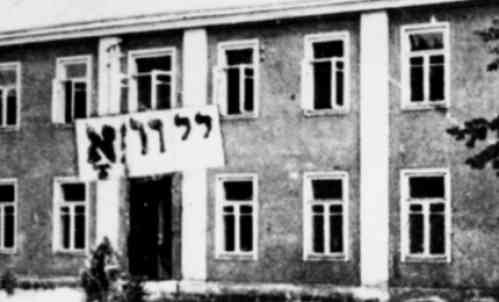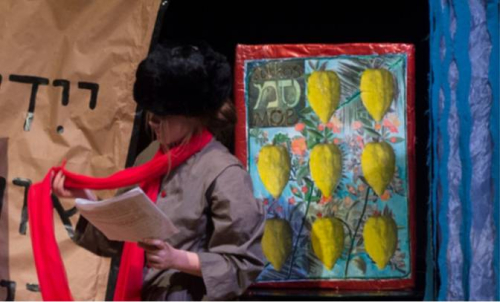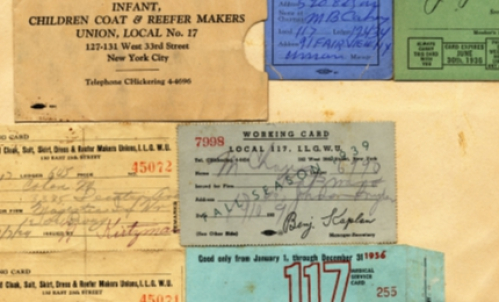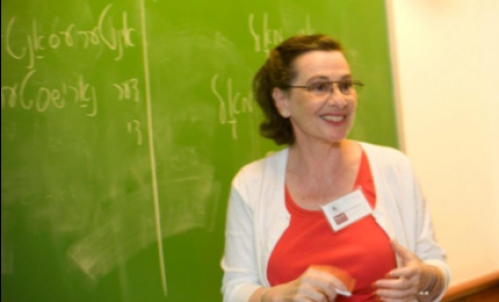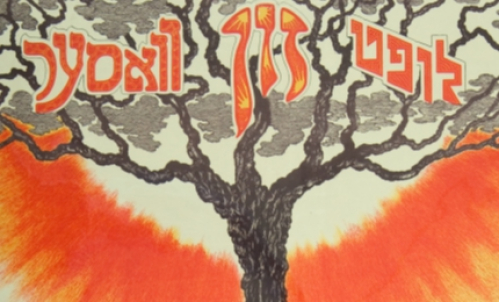2024 Winter Program
Course List · January 9 – 26, 2024
Masters of Yiddish Prose
Instructor: Curt Leviant
This course will focus on close readings of seven major early 19th to mid-20th century Yiddish writers, six in prose—the Hasidic leader and storyteller Reb Nachman of Bratslav, Sholem Aleichem, Chaim Grade, Isaac Bashevis Singer, Avrom Reyzen, Lamed Shapiro—and one in poetry: the fabulist, Eliezer Shtaynbarg, that will illuminate the life and culture of Jews in Eastern Europe.
With Reb Nachman (1772-1810)—the great-grandson of the founder of Hasidism, the Baal Shem Tov—and himself an influential Hasidic leader, we meet a teller of spontaneous oral tales (later written in Yiddish and Hebrew), who tells moral and mystical stories that defy easy explanation and even influenced modern masters like Franz Kafka. For Sholem Aleichem, an unusual work will be featured: a forgotten short novel called Moshkele the Thief. Reading Chaim Grade, we are immersed in selected chapters from his famous novel, The Yeshiva, viewing the line between a life of religiosity and the temptations of the outside world. The stories by Reyzen offer tender glimpses into family life, while Shapiro, for the first time in Yiddish literature, boldly depicts the violence Jews suffered when Russian and Ukrainian peasants unleashed pogroms against them.
For each session, students in this course will be given weekly reading assignments along with questions that will be answered in written form. These assignments, plus insights offered by the instructor and questions asked by the students, will shape the course. Curt Leviant has translated most of the readings, and selections will be drawn from the books he has edited and rendered into English from the original Yiddish.
The Food Culture of Ashkenaz: On Two Sides of the Atlantic
Instructor: Hasia Diner
In the broad swathe of Jewish habitation known as Ashkenaz, from Alsace in the west through to Ukraine in the east, food mattered. It mattered in religious law, in family and community celebration, among Jews of different regional backgrounds, and in the constant exchanges between Jews and their non-Jewish neighbors. How did those foodways, including ingredients, dishes, and ideas about eating function both before migration to the United States and afterwards? How did the Jews of the many regions of Ashkenaz interact with American food realities? This course makes food central to thinking about Jewish history and it will put a great deal of emphasis on class and gender.
Two Visions: Stalingrad and the Human World
Instructor: Jonathan Brent
The Battle of Stalingrad (August 23, 1942 – February 3, 1943) was one of the most brutal battles of World War II and certainly its most significant turning point. The Battle of Kursk in the summer of 1943 sealed Hitler’s fate and opened the way for the Allied landing on D-Day in June 1944, but it was Stalingrad with the capture and humiliation of Paulus’s 6th Army (and the Italian 4th Army) that demoralized and all but disabled Hitler’s mighty war machine. Axis casualties amounted to some 750,000; Soviet casualties are estimated at some 1,129,000. Over a million men and women died at Stalingrad, far surpassing the toll of any of the major battles of World War I.
Vasily Grossman, a Soviet Jewish journalist and novelist, had unique personal access to the day-to-day fighting during this horrific battle that coincided with the implementation of Hitler’s Final Solution. He lived with the Soviet troops, went on sniper missions, sat in on meetings of the General Staff, and filed report after report to Krasnaya Zvezda (Red Star), lifting the spirit of the beleaguered and fearful Soviet people. Grossman’s novel, Stalingrad (1952), represents a masterful synthesis of his experience and observations, and deeply meditates on war, the Holocaust, Stalin, and the meaning of the Soviet victory.
In the same year in which Grossman chronicled the events at Stalingrad, the thirteen-year-old Yitskhok Rudashevski (1927-1943) found himself in the Vilna Ghetto and began to keep a diary on daily events in the ghetto. Unlike Grossman, Rudashevski did not survive, and his slim diary, found by chance after the war, stands as a unique testament not to the clash of armies and ideologies, but to the cultural resistance of the Jews in the ghetto, the significance of their leadership, and the driving force of their spirit in the face of Nazi brutality.
These two works deserve to be read side by side, partly because the doomed Jews of the Vilna Ghetto closely followed the events of Stalingrad and cheered the Soviet victory—not knowing it was also that victory that sealed their fate—but principally because they provide two different visions of victory over the anti-human Nazi ideology and violence.
Jews in Pop and Rock Music
Instructor: Jonathan Karp
In this six-part course, we will examine the extraordinary role played by Jews in the development of American popular music, giving particular emphasis to the Rock ‘n’ Roll and classic Rock eras of the ‘50s and ‘60s. We’ll begin by looking at the origins of Jewish participation in the popular music industry, including the development of Tin Pan Alley sheet music publishing, Vaudeville, and Broadway song composing. Jews were involved in all aspects of the music industry, not just as songwriters but as agents and impresarios too. Next, we examine the emergence of mostly Jewish-owned independent record labels during the post-World War II period that initially specialized in Rhythm and Blues records for Black consumers but eventually served the newly emerging market of young white listeners thirsting for Rock ‘n’ Roll. Finally, we survey the great Jewish singer-songwriters like Carole King, Bob Dylan, Simon & Garfunkel, and Carly Simon who dominated the singer-songwriter era of the late ‘60s and ‘70s. A postscript will bring the story into the Age of Hip Hop, with Jewish entrepreneurs still playing a familiar role as brokers and innovative promoters of popular sounds.
Conquering the Space: Symbolic Topography of the Former Warsaw Ghetto
Instructor: Elżbieta Janicka
Burnt down and razed to the ground by the German Nazis, never systematically exhumed, the former Warsaw Ghetto site is at once a symbol and a physical reality. It symbolizes and embodies Jewish presence, identity, history, Jewish life, and death. It symbolizes and embodies the ultimate consequences of antisemitism. Its central location—in the center of Warsaw that is the center of Poland—symbolizes and embodies the central position of the Holocaust in the country’s social fabric.
How do Poles who exert control over this space treat this symbol and physical reality? What were the stages of its symbolic rendering? How does the former Warsaw Ghetto site look today and what does its present shape mean? Since—as any cultural landscape—it can be understood as a cultural text, what narrative patterns emerge from its urban design, memorials, commemorative plaques, murals, names of buildings, streets, and squares? Whose perspective do they convey?
While drawing on this rich iconography we will:
— outline the prewar, wartime, and postwar history of the site
— examine four basic narrative patterns imprinted in the former Warsaw Ghetto ground
— ask the question about the reasons of their persistence and intensifying repetitiveness between the revelation in 2000 of Polish participation in the Holocaust and the 2015 authoritarian turn in Polish politics
Our investigation of the former Warsaw Ghetto space will be informed by the observation that the space is at once a product and a means of production of power relations. We will try to figure out whether the discussed phenomena belong to the realm of memory or are a continuation of the past: namely of antisemitic domination, exclusion, and violence. Our question will be whether the observed spatial transformation of the Warsaw Ghetto site represents a broader process that led to the collapse of liberal democracy in this center of Europe.
Jews and American Radicalism in the 20th Century
Instructor: Tony Michels
This course explores the long history of Jews and the American left. Why have many Jews embraced socialism and other leftist ideologies? What role have they played in Jewish life? How have they served to divide or unite Jews in different time periods and circumstances? How have leftists dealt with issues such as Jewish nationalism, antisemitism, and racism? We will discuss these and other questions as they played out among Yiddish-speaking immigrants and American-born Jews, from the late 19th century through the era of the New Left and beyond.
The Jews of Argentina
Instructor: Ilan Stavans
An exploration of the history and culture of the Jews of Argentina, from the immigration to the agricultural colonies sponsored by Baron Maurice de Hirsch at the end of the 19th century and the "Semana Trágica" riots of 1919, to the growth of urban communities, the rise of Peronismo, the capture of former Nazi official Adolf Eichmann, the Dirty War and the desaparecidos, the terrorist attack against the AMIA (Asociación Mutual Israelita Argentina), and beyond. Themes include anti-Semitism, assimilation, activism, state repression, communal organization, Zionism and Israel, languages, gender roles, and self-defense. We will analyze poems, short stories, journalistic accounts, speeches, fragments of novels and memoirs, and films. Figures to be discusses are Alberto Gerchunoff, Jorge Luis Borges, Pope Francis, Marcos Aguinis, Daniel Barenboim, Marcelo Birmajer, Aída Bornik, Daniel Burman, Julio Cortázar, Juan Gelman, Rabbi Marshall Meyer, Alejandra Pizarnik, Ana María Shúa, and Jacobo Timerman, among others.
Yiddish Culture in the Ghettos and Camps
Instructor: Samuel Kassow
Through examination and discussion of Jewish writings from the Warsaw, Lodz, and Vilna ghettos, this minicourse will explore Jewish reactions to Nazi persecution. It will consider such issues as social tensions within the ghettos, the role of poetry and song, the use of ghetto archives as a key weapon of cultural resistance and Jewish perceptions of the future. While a great deal of Jewish wartime writing was in Polish, especially in Warsaw, Krakow, and Lviv (Lemberg), this minicourse will focus on Yiddish-language writing, in part because this was the language of most of the cultural activists in these ghettos. All readings will be in English translation.
The Final Draft – A Creative Writing Workshop
Instructor: Irena Klepfisz
Is there such a thing as a “final draft”? Or is this simply a contradiction in terms? This workshop will focus on the process of completing a poem and understanding when we should stop working on it.
Many of us have had the experience of writing something that comes to us in almost perfect form. This kind of first draft needs either no or very few minor edits or revisions. Probably more common is the experience of working on a text and then reworking it and then reworking it again. We simply cannot bring ourselves to put it away because it's far from what we had envisioned when we first started writing. Should we continue trying to refine it? Or should we put it away and accept failure?
There is no formula to writing poetry. But there are questions we can ask whose answers will help us not only understand when we're finished with a poem but will also move us forward into our next piece of writing. In the workshop, we will raise and try to answer these questions. In addition to analyzing poems from the workshop reader, participants will have the opportunity to present texts in progress or texts considered final.
American Hasidism
Instructor: Nathaniel Deutsch
The history of Hasidism in America is over a century old, dating back to the massive waves of Jewish immigration from Eastern Europe. Initially, the Hasidic presence on these shores consisted of a few minor leaders as well as transplanted congregations that traced their origins back to Hasidic communities in the Old Country, but whose members typically no longer maintained a Hasidic lifestyle. Compared to the millions of Jewish immigrants who sought to assimilate into American culture or who participated in Yiddish-speaking socialist organizations, Hasidim were a mere drop in the bucket. And yet, following World War II, this would change dramatically. Initially arriving as Holocaust refugees and quickly establishing enclaves in Brooklyn neighborhoods—and eventually beyond—Hasidim from several regions of Eastern Europe would, over the course of the next half century, become the fastest growing segment of the American Jewish population. In the process, they have called into question long-held assumptions regarding the Jewish relationship to culture, politics, and religion in the United States.
In this course, we will examine this history using selected readings from books such A Fortress in Brooklyn: Race, Real Estate, and the Making of Hasidic Brooklyn by Nathaniel Deutsch and Michael Casper, New World Hasidim: Ethnographic Studies of Hasidic Jews in America by Janet Belcove-Shalin, Race and Religion Among the Chosen Peoples of Crown Heights by Henry Goldschmidt, and Unorthodox: The Scandalous Rejection of My Hasidic Roots by Deborah Feldman. We will also examine a wide range of other sources, including Hasidic websites, social media, newspapers, and pashkeviln (“broadsides”).
